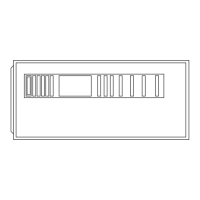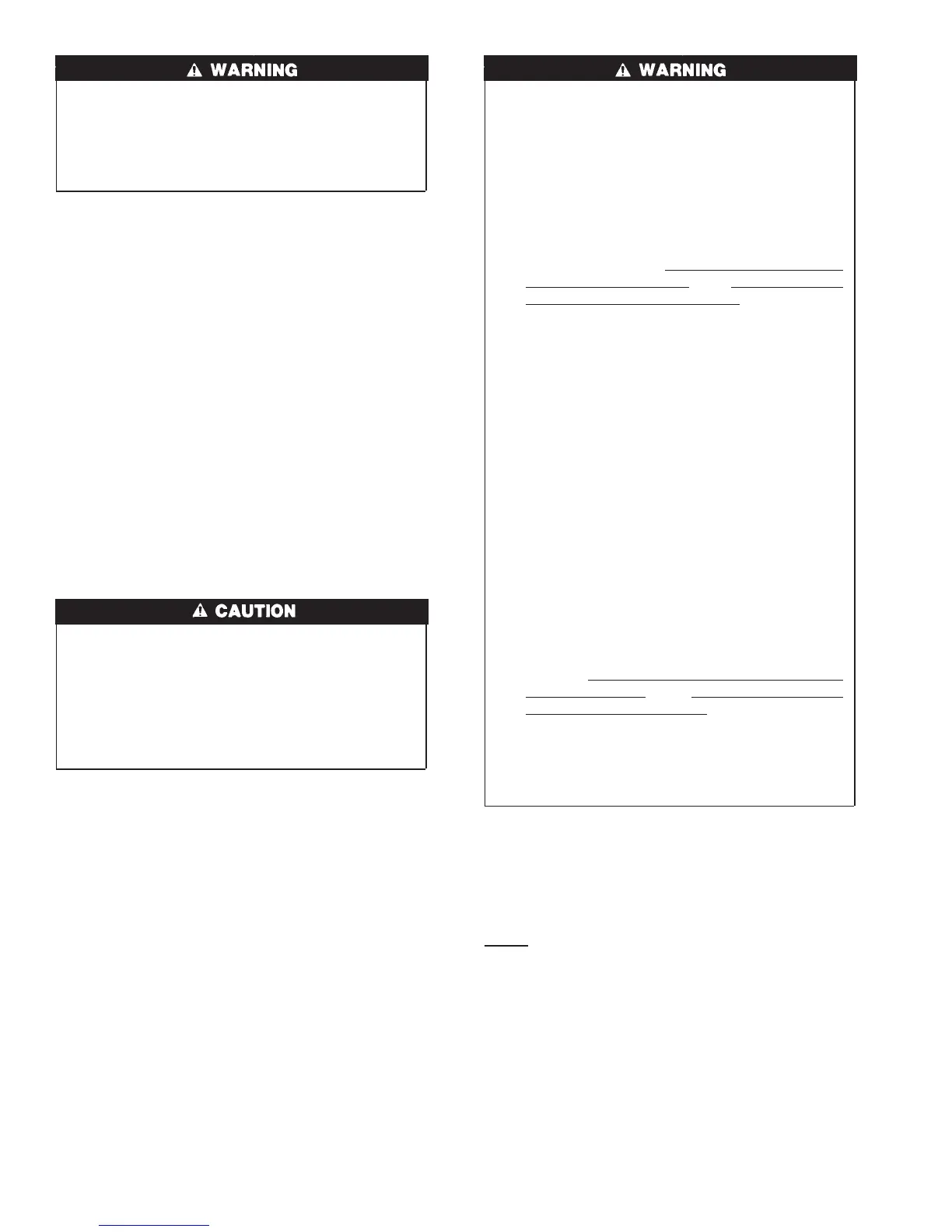ELECTRICAL SHOCK AND FIRE HAZARD
Failure to follow this warning could result in serious injury,
death, or property damage.
If manual disconnect switch is to be mounted on furnace,
select a location where a drill or fastener will not contact
electrical or gas components.
24–V WIRING
Connect 24-v thermostat leads to 24-v terminal block on furnace
control. For proper cooling operation, Y wire from thermostat
MUST be connected to Y/Y2 terminal on furnace control, as
shown in Fig. 27. The 24-v terminal block is marked for easy
connection of field wiring. (See Fig. 30.) The 24-v circuit contains
a 3-amp, automotive-type fuse located on furnace control. (See
Fig. 31.) Any electrical shorts of 24-v wiring during installation,
service, or maintenance may cause fuse to blow. If fuse replace-
ment is required, use only a fuse of identical size (3 amp) and type.
The control will flash code 24 when fuse needs replacement.
NOTE: Use AWG No. 18 color-coded copper thermostat wire
for lengths up to 100 ft. For wire lengths over 100 ft, use AWG No.
16 wire.
ACCESSORIES
1. Electronic Air Cleaner (EAC)
Two quick-connect terminals marked EAC-1 and EAC-2 are
provided for EAC connection. (See Fig. 31.) These terminals
are energized with 115-v (1.0-amp maximum) during blower
motor operation.
UNIT MAY NOT OPERATE
Failure to follow this caution may result in intermittent
operation or performance satisfaction.
DO NOT connect furnace control HUM terminal to HUM
(humidifier) terminal on Thermidistat™, Zone Controller or
similar device. See Thermidistat™, Zone Controller, thermo-
stat, or controller manufacturer’s instructions for proper
connection.
2. Humidifier (HUM)
A quick-connect terminal (HUM) and screw terminal (C
OM
24V) are provided for 24-v humidifier connection. (See Fig.
30.) HUM terminal is energized with 24-v (0.5-amp maxi-
mum) when gas valve is energized.
NOTE: A field-supplied, 115-v controlled relay connected to
EAC terminals may be added if humidifier operation is desired
during all blower operation.
Step 9—Direct Venting
The 58MXA furnaces require a dedicated (one 58MXA furnace
only) direct-vent system. In a direct-vent system, all air for
combustion is taken directly from outdoor atmosphere, and all flue
gases are discharged to outdoor atmosphere.
REMOVAL OF EXISTING FURNACES FROM COMMON
VENT SYSTEMS
When an existing Category I furnace is removed or replaced, the
original venting system may no longer be sized to properly vent
the remaining attached appliances. An improperly sized Category
I venting system could cause the formation of condensate in the
furnace and vent, leakage of condensate and combustion products,
and spillage of combustion products into the living space, etc.
CARBON MONOXIDE POISONING HAZARD
Failure to follow the steps outlined below for each appliance
connected to the venting system being placed into operation
could result in carbon monoxide poisoning or death.
The following steps shall be followed for each appliance
connected to the venting system being placed into operation,
while all other appliances connected to the venting system are
not in operation:
1. Seal any unused openings in venting system.
2. Inspect the venting system for proper size and horizontal
pitch, as required in the National Fuel Gas Code, ANSI
Z223.1-2002/NFPA 54-2002 or the CSA B149.1, Natu-
ral Gas and Propane Installation Code and these instruc-
tions. Determine that there is no blockage or restriction,
leakage, corrosion and other deficiencies, which could
cause an unsafe condition.
3. As far as practical, close all building doors and windows
and all doors between the space in which the appli-
ance(s) connected to the venting system are located and
other spaces of the building.
4. Close fireplace dampers.
5. Turn on clothes dryers and any appliance not connected
to the venting system. Turn on any exhaust fans, such as
range hoods and bathroom exhausts, so they are operat-
ing at maximum speed. Do not operate a summer
exhaust fan.
6. Follow the lighting instructions. Place the appliance
being inspected into operation. Adjust the thermostat so
appliance is operating continuously.
7. Test for spillage from draft hood equipped appliances at
the draft hood relief opening after 5 minutes of main
burner operation. Use the flame of a match or candle.
8. If improper venting is observed during any of the above
tests, the venting system must be corrected in accordance
with the National Fuel Gas Code, ANSI Z223.1-
2002/NFPA 54-2002 and/or CSA B149.1, Natural Gas
and Propane Installation Codes.
9. After it has been determined that each appliance con-
nected to the venting system properly vents when tested
as outlined above, return doors, windows, exhaust fans,
fireplace dampers and any other gas-fired burning appli-
ance to their previous conditions of use.
Vent system or vent connectors may need to be resized. For any
other appliances when resizing vent systems or vent connectors,
system or connector must be sized to approach minimum size as
determined using appropriate table found in the NFGC or NSC-
NGPIC.
COMBUSTION-AIR AND VENT PIPING
General
Combustion-air and vent pipe, fittings, primers, and solvents must
conform to American National Standards Institute (ANSI) stan-
dards and American Society for Testing and Materials (ASTM)
standards. See Table 6 for approved materials for use in the U.S.A.
In Canada construct all combustion-air and vent pipes for this
furnace of CSA or ULC listed schedule-40 PVC, PVC-DWV or
ABS-DWV pipe and pipe cement. SDR pipe is NOT approved in
Canada.
See Table 7 for maximum pipe lengths and Fig. 36, 37, 38, 39, and
40 for exterior piping arrangements.
22
→

